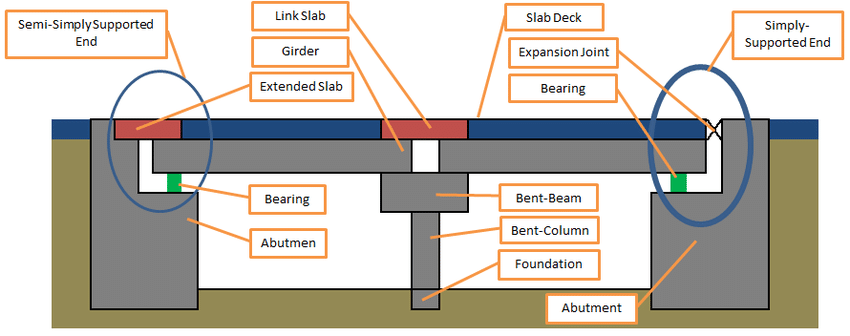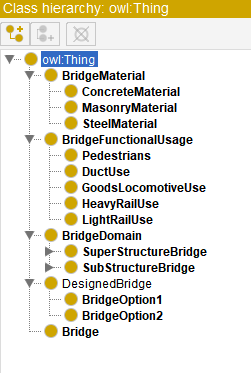Introduction
An Ontology is a space which is mainly designed for the researchers who need to share information in a domain. Additionally, it is very helpful for common people in order to understand the detailing of the components of the system working on. The basic function of Ontologies are that there will be designer who designs the system and upload it to a domain. Ontology has many definitions in the field of Artificial Intelligence. I am more concerned with the Bridge System where the ontology covers the structural components defined along with their properties.
System Overview
Purpose of the ontology developed in this work is to provide an overview for all basic elements and concepts used in a design process of Bridge.
Fig1. Schematic representation of the substructure and superstructure of a bridge
The developed ontological model has the claim to describe the bridge as just described as a whole. Therefore, four classes were defined, each representing a domain of a bridge. Afterwards each class becomes more and more detailed according to the top-down principle.
- Physical Components – The main focus of the structural engineering of the bridge is its components. Bridge as a whole is a mixture of two or more structural elements. The main structural components can be categorized as following
- Substructure- The part of the bridge that is directly contacted with the soil and it supports the upper component of the bridge. The components included in this are Foundation(Pile and Pile Cap), Abutment, Pier, Pier Cap, Wing and Return Walls.
- Superstructure- The part supported by the substructure is Superstructure. In railway bridge system, this part will be in direct contact with the rail lines. This can be again classified as Bearing, Deck/Slab, Truss, Primary Member(Arch, Girder), Secondary Member(Cross Girder, lateral Bracing)
- Main Material- This part defines about the materials that are used in the construction of the physical components. In modern bridge engineering[3], the main material used for the substructure is concrete, although in the past other materials such as masonry or stone were used for the substructure. But in our ontology we avoided the later mentioned ones. Regarding the superstructure, there is a higher variation of possible materials such as Steel and Concrete and the choice of material influences its structural configuration. For finishing the physical components, often masonry are used.
- Uses- a use define for a bridge influences its structural configuration, and loads. When using a bridge (BridgeFunctionalUsage) one can distinguish between pedestrians, bicyclists, motor vehicles and trains (and in exceptional cases even ships and airplanes).
Developing and Ontology
Considering the ontology of Bridge, we are focusing on the construction aspect in which the structural properties are included. Naturally, when constructing a bridge, there can be different types of components and there alternatives. It is sensible to use the best combination of components to get the best result. Bridges are mainly used for the purpose of transportation such as transportation by any modes, pedestrians etc.
When developing an Ontology, it is very much advisable to answer the key questions:-
1.What is the purpose?
This ontology is developed to represent how a Bridge is conceptually designed with the input of certain parameters. So it is mainly focusing on the structural engineering.
2.What is the scope?
To design our system, the ontology needs to include some components such as bridge physical components, possible materials used for the components, and functional usage and their relation.
3.Who are the intended end-users?
The intended end-users are the designers and engineers involved in the design process. Customers can also be categorized as end user in certain cases.
4.What is the intended use?
Our ultimate target was the theoretical design of the Bridge. So it is intended to be used as knowledge representation to support the creation of the parametric modeling, specially target at being used for structural analysis.
According to Noy and McGuinness[1], an ontology must help us to clearly answer certain basic questions like what the domain is, the purpose of ontology, the type of information in the ontology and who will use and maintain the ontology.
Domain- In this assignment, we are working on the ontology of Bridge. So this will be our actual domain
Scope- Like mentioned before, the scope lies in defining each components in the construction of the bridge which includes physical components, materials used and usage.
Now we can define the classes and the class hierarchy for the Bridge. By using the top-down development process we can define the class and class hierarchy as shown in Figure 2 and the relationships between the classes and the subclasses is shown in Figure 3.
Fig2. Structure of Ontology
Fig3. Relationship between subclasses and classes
Owl File :- bridge-ontology-modelling
References
Natalya F.Noy, Deborah L. McGuiness., Stanford University, Stanford, “Ontology Developing: A Guide to Creating your first Ontology”.
H. Al-Hakam., S. Raimer J., 2020. “Integration of BIM-related Bridge information in an Ontological knowledgebase”.
Gruninger, M. and Fox, M.S. (1995). Methodology for the Design and Evaluation of Ontologies. In: Proceedings of the Workshop on Basic Ontological Issues in Knowledge Sharing, IJCAI-95, Montreal.


